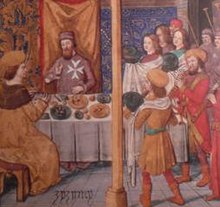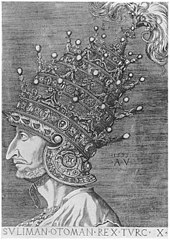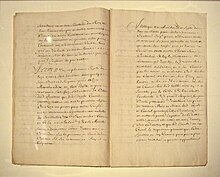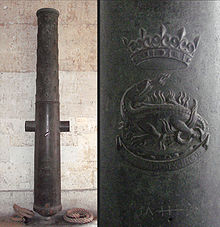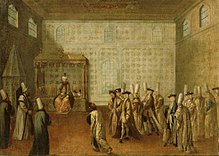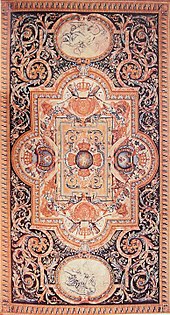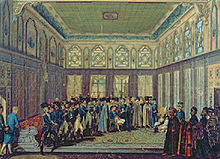Franco-Ottoman alliance
Philippe de Commines reports that Bayezid II sent an embassy to Louis XI in 1483, while Cem, his brother and rival pretender to the Ottoman throne was being detained in France at Bourganeuf by Pierre d'Aubusson.
[11] A momentous intensification of the search for allies in Central Europe occurred when the French ruler Francis I was defeated at the Battle of Pavia on February 24, 1525, by the troops of Emperor Charles V. After several months in prison, Francis I was forced to sign the humiliating Treaty of Madrid, through which he had to relinquish the Duchy of Burgundy and the Charolais to the Empire, renounce his Italian ambitions, and return his belongings and honours to the traitor Constable de Bourbon.
[14] In December 1525 a second mission was sent, led by John Frangipani, which managed to reach Constantinople, the Ottoman capital, with secret letters asking for the deliverance of king Francis I and an attack on the Habsburg.
Know that it will be as said.The plea of the French king nicely corresponded to the ambitions of Suleiman in Europe, and gave him an incentive to attack Hungary in 1526, leading to the Battle of Mohács.
[16] With the War of the League of Cognac (1526–1530) going on, Francis I continued to look for allies in Central Europe and formed a Franco-Hungarian alliance in 1528 with the Hungarian king Zapolya, who himself had just become a vassal of the Ottoman Empire that same year.
[23] In July 1533 Francis received Ottoman representatives at Le Puy, and he would dispatch in return Antonio Rincon to Barbarossa in North Africa and then to the Asia Minor.
To this objective, next summer, he [the King of France] with send the military force he is preparing to recover what it unjustly occupied by the Duke of Savoy, and from there, to attack the Genoese.
[38] Saint-Blancard in vain attempted to convince the Ottomans to again raid the coasts of Apulia, Sicily and the March of Ancona, and Suleiman returned with his fleet to Constantinople by mid-September without having captured Corfu.
[42] Although the French accompanied most of the campaigns of Barbarossa, they sometimes refrained from participating in Turkish assaults, and their accounts express horror at the violence of these encounters, in which Christians were slaughtered or taken as captives.
[44] Charles V turned his attention to fighting the Ottomans, but could not launch large forces in Hungary due to a raging conflict with the German princes of the Schmalkaldic League.
Open conflict between Charles and Francis would resume in 1542, as well as Franco-Ottoman collaboration, with the 4 July 1541 assassination by Imperial troops of the French Ambassador to the Ottoman Empire Antonio Rincon, as he was travelling through Italy near Pavia.
The course of the war saw extensive fighting in Italy, France, and the Low Countries, as well as attempted invasions of Spain and England; but, although the conflict was ruinously expensive for the major participants, its outcome was inconclusive.
In the Mediterranean, active naval collaboration took place between the two powers to fight against Spanish forces, following a request by Francis I, conveyed by Antoine Escalin des Aimars, also known as Captain Polin.
[61] Jerôme Maurand, a priest of Antibes who accompanied Polin and the Ottoman fleet in 1544, wrote a detailed account in Itinéraire d'Antibes à Constantinonple.
Besides the powerful effect of a strategic alliance encircling the Habsburg Empire, combined tactical operations were significantly hampered by the distances involved, the difficulties in communication, and the unpredictable changes of plans on one side or the other.
[68] In the late sixteenth century, Italian political philosopher Giovanni Botero referred to the alliance as "a vile, infamous, diabolical treaty" and blamed it for the extinction of the Valois dynasty.
[69] Even the French Huguenot Francois de La Noue denounced the alliance in a 1587 work, claiming that "this confederation has been the occasion to diminish the glory and power of such a flourishing kingdom as France.
[68] Scientific exchange is thought to have occurred, as numerous works in Arabic, especially pertaining to astronomy were brought back, annotated and studied by scholars such as Guillaume Postel.
Through the services of his ambassador Jean Cavenac de la Vigne, Henry II obtained the dispatch of an Ottoman fleet to Italy in 1558, with little effect however apart from the sack of Sorrento.
In 1566, under Charles IX, the French ambassador to the Ottoman Empire intervened in favour of the Dutch Revolt against the Spanish Empire, after a request for Ottoman help by William I of Orange, so that a Dutch-Ottoman alliance was considered and a letter was sent from Suleiman the Magnificent to the "Lutherans" in Flanders, offering troops at the time they would request,[86] and claiming that he felt close to them, "since they did not worship idols, believed in one God and fought against the Pope and Emperor".
Various religious refugees, such as the Huguenots, some Anglicans, Quakers, Anabaptists or even Jesuits or Capuchins and Jews (Marranos) were able to find refuge at Constantinople and in the Ottoman Empire,[35] where they were given right of residence and worship.
In 1572, after the death of the Polish king Sigismund Augustus, who had been under a Polish-Ottoman alliance of his own, Poland elected the French Henri de Valois, rather than Habsburg candidates, partly in order to be more agreeable to the Ottoman Empire.
Louis refused to participate in the Holy League, a coalition of European powers against the Ottomans, adopting a position of neutrality, and encouraged Mehmed IV to persevere in his fight against the Habsburgs.
[111][114] Pamphleters and poets would criticize the position of Louis, and reinforce the unity of the League, by describing a battle between European "Liberty" on the one hand and "Eastern despotism" associated with "French absolutism" on the other.
[117] By the end of the 17th century, the first major defeats of the Ottoman Empire reduced the perceived threat in European minds, which led to an artistic craze for Turkish things.
The French officer and adventurer Claude-Alexandre de Bonneval (1675–1747) went in the service of Sultan Mahmud I, converted to Islam, and endeavoured to modernize the Ottoman Army, creating cannon foundries, powder and musket factories and a military engineering school.
Napoleon Bonaparte invaded Egypt in 1798 and fought against the Ottomans to establish a French presence in the Middle East, with the ultimate dream of linking with Tippoo Sahib in India.
[138] Britain took the opportunity to ally with the Ottoman Empire in order to repel Napoleon's invasion, intervening militarily during the siege of Acre with Admiral William Sidney Smith in 1799, and under Ralph Abercromby at the Battle of Abukir in 1801.
Your dynasty is about to descend into oblivion... Trust only your true friend, FranceIn February 1806, following Napoleon's remarkable victory in the Battle of Austerlitz in December 1805 and the ensuing dismemberment of the Holy Roman Empire, Selim III finally refused to ratify the Russian and British alliances, and recognized Napoleon as Emperor, formally opting for an alliance with France "our sincere and natural ally", and war with Russia and Britain.
Selim III repelled the British fleet of John Thomas Duckworth with the help of Sebastiani, but lost several major encounters against Russia, and he was finally toppled by his Janissaries as he was trying to reform his army, and replaced by Sultan Mustafa IV.

